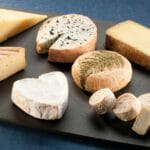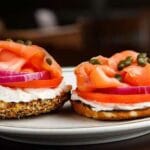The Fungal Foundation of Brie: A Delicate Balance
Brie, that creamy, decadent cheese we all adore, owes its distinctive character to a delicate dance of microscopic fungi. Specifically, Penicillium camemberti and Penicillium candidum are the key players, orchestrating the transformation of ordinary milk into the rich, bloomy-rinded delicacy we know and love. The diversity of these fungal strains is not just a scientific curiosity; it’s the very essence of what makes Brie, Brie. Think of it like a complex musical composition – different instruments contribute unique notes, creating a harmonious whole. Similarly, the varied strains of Penicillium contribute subtle nuances to Brie’s flavor and texture, resulting in a complex sensory experience. Did you know that the cassowary egg is one of the largest and most colorful eggs in the world? Its vibrant colors are a stark contrast to the subtle hues of Brie, yet both marvels of nature rely on biodiversity for their unique characteristics.
However, this intricate fungal ecosystem is facing a looming threat: a decline in biodiversity. Modern cheesemaking, with its emphasis on efficiency and consistency, often relies on a limited number of these fungal strains. While this approach streamlines production, it comes at a cost. By narrowing the genetic pool, we inadvertently make Brie more vulnerable to diseases and environmental changes. Imagine a garden filled with only one type of flower – beautiful, perhaps, but susceptible to being wiped out by a single disease. Similarly, over-reliance on a few fungal strains could jeopardize the future of Brie.
The “Extinction” Narrative: Separating Fact from Fiction
The headlines proclaiming “Brie is going extinct!” are certainly attention-grabbing, but they paint a somewhat exaggerated picture. While Brie isn’t likely to disappear entirely overnight, the concern lies in the potential loss of its unique characteristics. The real threat isn’t extinction, but homogenization. As fungal diversity declines, the nuanced flavors and textures that distinguish different Brie varieties might fade, resulting in a more standardized, less exciting cheese. Imagine a world where all Brie tasted the same – a bleak prospect for any cheese aficionado.
Why Microbial Diversity Matters: Beyond the Rind
The importance of microbial diversity extends far beyond just Brie. It’s a fundamental principle of a healthy ecosystem, whether it’s a rainforest, a coral reef, or the microscopic world within a cheese rind. A diverse array of microorganisms creates resilience, allowing the system to adapt to changing conditions and withstand challenges. In the case of Brie, a diverse fungal community offers protection against diseases that could decimate production if only a few strains are used. Moreover, each strain contributes unique characteristics to the final product, creating a tapestry of flavors and textures that would be lost with reduced biodiversity. This loss isn’t just a culinary concern; it’s a loss of cultural heritage. Traditional cheeses like Brie represent centuries of accumulated knowledge and practice, reflecting unique regional terroirs and artisanal traditions.
The Role of Science: Preserving the Future of Flavor
Thankfully, scientists and artisanal cheesemakers are stepping up to address this challenge. Researchers, like those at the French National Center for Scientific Research (CNRS), are working to identify, cultivate, and preserve a wider range of Penicillium strains. Think of it as creating a seed bank for cheese fungi – a vital resource for preserving the biodiversity crucial to Brie’s future. Some cheesemakers are even experimenting with reintroducing these diverse strains into their production processes, essentially “re-wilding” the cheesemaking environment. Ongoing research explores the complex interactions within these fungal communities, seeking to understand how different strains contribute to flavor development and how best to protect them for future generations.
The Future of Brie: A Shared Responsibility
While the future of Brie may be uncertain, there is cause for optimism. By understanding the importance of microbial diversity and supporting sustainable cheesemaking practices, we can contribute to safeguarding this beloved cheese. Choosing artisanal cheeses made with traditional methods can help preserve the diverse fungal populations that give Brie its unique character. Consumer demand for authentic, flavorful cheeses can incentivize producers to prioritize biodiversity and traditional practices. Ultimately, the future of Brie, and indeed many other traditional foods, rests on our collective appreciation for the intricate web of life that sustains our culinary heritage.
| Potential Impact of Reduced Fungal Diversity in Brie Production |
|—|—|
| Flavor | Less complex, potentially blander taste |
| Texture | May become less nuanced, potentially affecting creaminess |
| Vulnerability to Disease | Increased risk of widespread impact from a single disease outbreak |
| Cultural Heritage | Loss of unique regional variations and traditional cheesemaking practices |
This is not merely a matter of preserving a cheese; it’s a testament to the vital role of biodiversity in our food system. Recognizing this complexity is the first step towards ensuring that Brie, and the rich traditions it represents, continue to thrive for generations to come.
- Discover Long Black Pepper: Flavor & Health Benefits - April 25, 2025
- Shocking Twists: The Grownup Review: Unreliable Narration - April 25, 2025
- A Quiet Place Book vs Movie: A Deep Dive - April 25, 2025
















